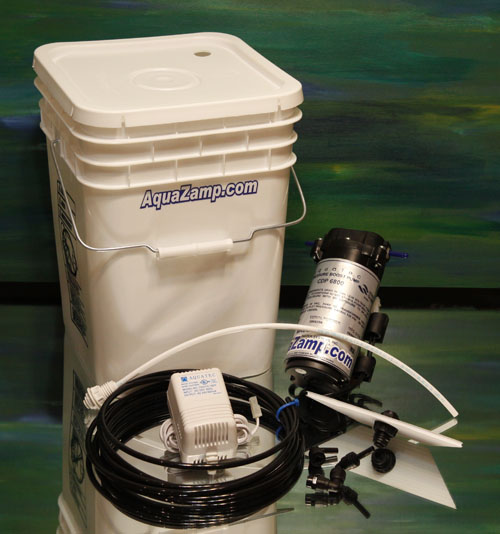[ad#300]
Automation of daily maintenance is one of the best decisions that I have ever made regarding time management. Providing for geckos that need high humidity, “rain”, or lots of water can be a real chore when you have to fill up your misting bottles daily and spend large amounts of time in front of the enclosure misting away. If you have to go out of town or are running late or are simply busy, then what? In this article I will give you an overview on misting systems in general and specifics about how to set them up.
[ad#sponsor]
Misting System?
A misting system is as simple as it sounds: a nozzle that emits a spray of water wherever you set it up. However the parts that make up a reptile system are a little different than your backyard types that attach to a normal hose bib. A typical misting system is made up of 3 major parts: the reservoir (source), the pump, and the nozzles. The pump pulls water from the reservoir and pushes it through plastic tubing to the nozzles where it then exits as a fine mist.
Why Use a Misting System?
One of the keys to keeping reptiles successfully is being able to spend quality time with them. When you have several animals, the amount of time that you are able to spend with each individual goes down. Getting a misting system will allow you to spend more time with each animal by eliminating the need to hand-mist them. It will also allow you to more accurately control the humidity, the amount of water, when they are watered, etc. They are also especially nice because they allow you to leave your reptile and not to worry about whether they are getting water or not. Systems like the ones Aqua Zamp sells are easy to set up and can be used on several enclosures.
Setting Up Your System
Misting vendors almost always sell kits which include everything that you need to set up your own system. Here at Tiki Tiki Reptiles we use Aqua Zamp (www.aquazamp.com) products because of the excellent customer service and also because nearly 90% of their components are made in the USA. A typical kit will include a reservoir bucket, a pump, a programmable timer, tubing, a nozzle and the necessary fittings. To assemble your kit you will first need to screw a bulkhead into the reservoir. This will connect the tube from the bucket to the pump. Next place your nozzle in the enclosure. This can be done several ways depending on what type of enclosure that you have. It is generally an easy task. Once you have done that, run the included tube from the pump to your nozzle. Now that your installation is complete you only need to set your timer for when you would like it to go off.
When to Mist
When you mist depends on what type of gecko you have and what kind of environment you need to emulate. Electronic timers are very nice as you can set them to go on and off several times a day in one minute increments, and if you get a really nice timer you can control misting times down to the second. If you need to keep the humidity high then you will want to mist several times a day for short durations. If you need lots of water to perhaps simulate a monsoon season you can have it go off for several minutes a day. An electronic timer is also nice because if needed you can set it to go off during the night when most geckos are active.
Upgrading
Even the most basic systems can be upgraded and customized to what you need them to do. If you have more than one enclosure then you can simply buy more nozzles to add in line with your first one. Most pumps can handle at least 12 nozzles.
If you are unable to mount a nozzle or need large rain like drips instead of mist, then you can use the Aqua Zamp Rain Dome which sits on top of any enclosure and allows the mist to collect inside and then rain down into the enclosure below.
You can also eliminate the reservoir if you have a water source nearby. You are able to purchase an adaptor that will allow you to branch off of almost any waterline in your home. From there you can buy an electronic solenoid from Aqua Zamp that allows you to plug your house water directly into your pump, eliminating the need for any water storage. With this method you are also able to add in a water filter to help eliminate nozzle clogging and scale build-up on your enclosures.
Try One!
A basic misting kit should cost you around $150, which is a small investment when you consider how much time that will be saved and will allow you to spend more one on one time with your animals. I highly recommend trying a misting system for yourself. Or at least check out the Aqua Zamp web site or see a system in person at one of the several shows that they attend thought the year.









Automated tanks are a must, especially if you have many of them. If i had to do things all over again I would have gotten holes drilled in my baby tanks as well.